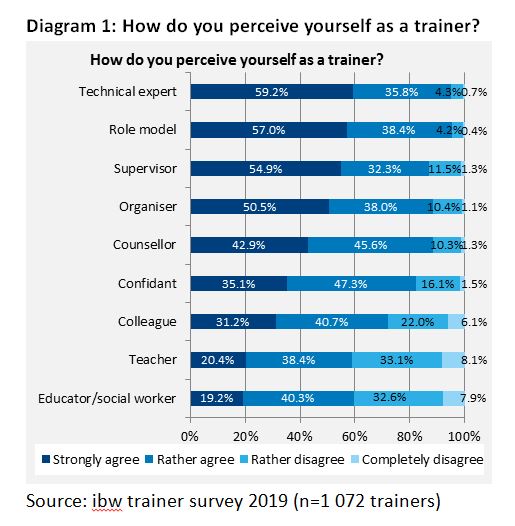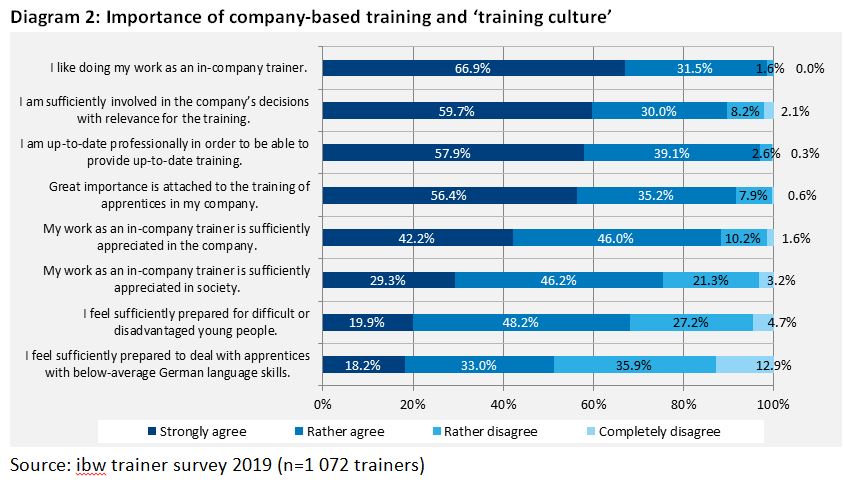In-company trainers are responsible for about 80% of the apprentices' training time. This means they play a key role in the dual training system but have received little attention so far. An ibw survey conducted among 1 000 trainers now gives this group more visibility. A positive fact that emerged is that 98% of the trainers enjoy their work.
The aim of the online survey conducted in January 2019 on behalf of the Federal Ministry for Digital and Economic Affairs (BMDW) among 1 072 in-company apprenticeship trainers in Austria was to shed light on the challenge of dual training from the perspective of this important influential group. At the same time, the survey aimed to develop better understanding of the trainers’ role and self-image.
Technical expert, confidant and educator
The survey results (Diagram 1) show that trainers today assume many different roles. While their agreement with the roles of technical expert (knowledge mediator) (95%) and supervisor (87.2%) confirms the traditional model, the interviewees also perceive themselves to a large extent as role models (95.4%), organisers (88.5%), counsellors (88.5%) and confidants (82.4%) (responses were ‘strongly agree’ or ‘rather agree’). Almost 60% also see themselves as educators or social workers. This diversity of roles is both a reflection of social changes, which are increasingly transferring social roles to the education and training sector, and an expression of changing fields of activity and tasks in company-based training.

98% of the trainers enjoy their work
The survey also demonstrates the high significance of apprenticeship training in most enterprises (Diagram 2): 91% of respondents think that the training of apprentices in their company is of great importance, 88% feel that their work as trainers is sufficiently appreciated in the company, whereas appreciation in society is perceived as less pronounced (66%).
A remarkable 98% of the trainers stated that they enjoy their work as trainers. This high rate of motivation among in-company trainers undoubtedly represents an enormous potential for the successful further development of apprenticeship training in Austria.

Lack of qualified apprentices is still a challenge
The respondents see the qualitative and quantitative shortage of apprentices as the greatest challenge. This is mainly attributed to demographic developments and the resulting increase in competition for young people between companies and also between upper secondary schools. 80% of the trainers see the too low number of qualified/good applications as a current challenge; 70% also consider the generally too few applications for their vacant apprenticeship posts a challenge. This quantitative deficiency is exacerbated by qualitative problems. For example, 68% of those surveyed (strongly or rather agree) attest to a lack of general training maturity among young people. From the trainers' point of view, additional significant difficulties are the distraction of apprentices by their mobile phones (70%) and the burden of the constantly increasing documentation and administrative workload (64%).
Source and further information:
Dornmayr, H.; Lengauer, B.; Rechberger, M. (2019a). In-company trainers in Austria. ibw research brief, Issue No 103, Vienna.
Dornmayr, H.; Lengauer, B.; Rechberger, M. (2019b). Betriebliche AusbilderInnen in Österreich. ibw-Forschungsbericht No 196, Vienna.



